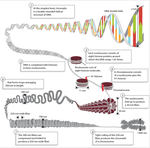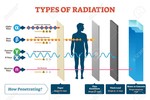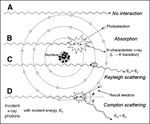This webpage is used to describe the physical and biological concepts and processes that are involved in the Radiation Biophysics course (PHY4274).
We will continue improving this webpage.
Your feedbacks and suggestions are greatly appreciated.
Your simple click of “like” at the end of each item would encourage us to work hard on building this webpage.
Repair pathways of DNA damages [with exercise questions]
Single-strand break repair: Hereditary defects in the repair of DNA damage are implicated in a variety of diseases, many of which are typified by neurological dysfunction and increased genetic instability and cancer. Of the different types of DNA damage that arise in cells, single-strand breaks (SSBs) are the most common, arising at a frequency of tens of thousands per cell per day from direct attack by intracellular metabolites and from spontaneous DNA decay.
DNA packaging in cell [with exercise questions]
Cells have DNA, the blueprint of life. DNA consists of two chains of sugar, phosphate and four different bases. As the genetic information is incorporated in the arrangement of these bases, bases are combined firmly to mutually act as a template in order to maintain the arrangement. When DNA is irradiated, it may be partially damaged depending on the amount of radiation.
DNA is small but very long The haploid human genome contains approximately 3 billion base pairs of DNA packaged into 23 chromosomes.
Central dogma, translation, transcription [with exercise questions]
Central dogma The central dogma of molecular biology is an explanation of the flow of genetic information within a biological system. It is originally stated as “DNA makes RNA, and RNA makes protein”.
The dogma is a framework for understanding the transfer of sequence information between information-carrying biopolymers, in the most common or general case, in living organisms. There are 3 major classes of such biopolymers: DNA and RNA (both nucleic acids), and protein.
Chromosome aberrations [with exercise questions]
Chromosomal aberration, or chromosomal mutation, is a missing, extra, or irregular portion of chromosomal DNA. These can occur in the form of numerical abnormalities (gains and losses) or structural abnormalities (deletions, inversions, and exchanges). Generally, chromosomal aberrations are going to be deleterious and lead to many genetic diseases. Numerical abnormalities can result in spontaneous abortions and severe birth defects. Structural abnormalities can lead to birth defects, cancer, and other late onset disease outcomes.
What is radiation? Electromagnetic & Particulate radiations [with exercise questions]
What is Radiation? In physics, radiation is defined as energy that travels through space or matter in the form of a particle or wave. It can be produced in one of two ways: by radioactive decay of an unstable atom (radionuclide), or by the interaction of a particle with matter. Some attributes of radioactive decay are spontaneousness and randomness. The type of radiation emitted depend on the specific radionuclide. Radiation emission as the result of an interaction depends on both the incoming particle and the material it hits, and is theoretically predictable if enough information is known.
Wavelength, frequency, energy [with exercise questions]
As we've discussed before, electromagnetic radiation is essentially electromagnetic wave (or a photon in a particulate view) and have no mass. The important properties that differs different electromagnetic radiations is their wavelength, which also determines frequency and energy.
Wavelength Wavelength, distance between corresponding points of two consecutive waves. “Corresponding points” refers to two points or particles in the same phase. Wavelength is usually denoted by the Greek letter lambda (λ); it is equal to the speed (v) of a wave train in a medium divided by its frequency (f): λ = v/f.
Proton, neutron, α, β, γ, X-ray [with exercise questions]
Overview Ionizing radiation is radiation, traveling as a particle or electromagnetic wave, that carries sufficient energy to detach electrons from atoms or molecules, thereby ionizing an atom or a molecule. Ionizing radiation is made up of energetic subatomic particles, ions or atoms moving at high speed, and electromagnetic waves on the high-energy spectrum.
Ionizing radiation takes a few forms: Alpha, beta, and neutron particles, and gamma and X-rays. All types are caused by unstable atoms, which have an excess of energy or mass.
Absorption of x-ray photon
Compton Scattering Compton scattering, discovered by Arthur Holly Compton, is the scattering of a photon by a charged particle, usually an electron. If it results in a decrease in energy (increase in wavelength) of the photon (which may be an X-ray or gamma ray photon), it is called the Compton effect. Part of the energy of the photon is transferred to the recoiling electron.
In 1923, Compton published a paper in the Physical Review that explained the X-ray shift by attributing particle-like momentum to light quanta.
Radiation energy deposition [with exercise questions]
Radiation Energy Deposition The energy from ionizing radiations is not deposited uniformly in the absorbing medium but is located along the tracks of the charged particles set in motion—electrons in the case of X- or gamma-rays, protons, and alpha-particles in the case of neutrons. Radiation chemists speak in terms of “spurs,” “blobs,” and “short tracks.” There is, of course, a full spectrum of energy event sizes, and it is quite arbitrary to divide them into just three categories, but it turns out to be instructive.
Linear energy transfer (LET) [with exercise questions]
Linear energy transfer LET is defined as the ratio of energy transferred by a charged particle ($dE_{local}$) to the target atoms along its path through tissue ($dx$). In other words, LET is a measure of the density of ionizations along a radiation beam. $$LET(keV/\mu m) = \frac{dE_{local}}{dx}$$ Higher LET radiations (particles: alpha particles, protons, and neutrons) produce greater damage in a biologic system than lower LET radiations (electrons, gamma rays, x-rays).
Unit of Radiation dose: Gy [with exercise questions]
Unit of Radiation Dose The gray (symbol: Gy) is a derived unit of ionizing radiation dose in the International System of Units (SI). It is defined as the absorption of one joule of radiation energy per kilogram of matter.
The measurement of absorbed dose in tissue is of fundamental importance in radiobiology and radiation therapy as it is the measure of the amount of energy the incident radiation deposits in the target tissue.
Radiation detection by the cloud chamber
Cloud Chamber Radioactive elements continually undergo a process of radioactive decay during which their nuclei emit high-speed particles and rays. These are much too small to be seen under a microscope. cloud chamber is a particle detector used for visualizing the passage of ionizing radiation and was invented by an English physicist, C. T. R. Wilson, in 1911. It is an instrument designed for the study of the trails of radioactive emissions.










